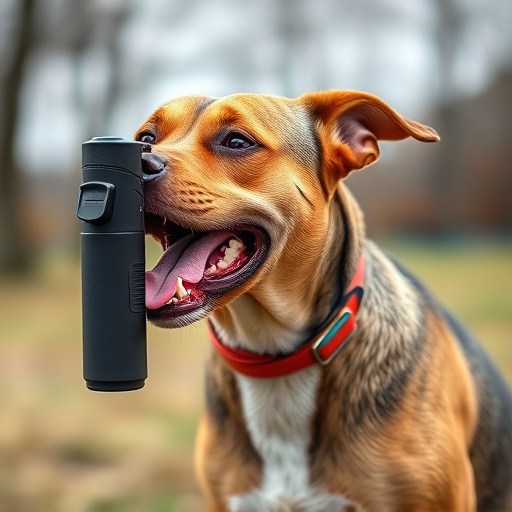Mace spray animal control requires understanding mechanics, safety precautions, and animal behavior. Choose the right mace spray for each scenario, practice techniques like aiming at leg targets or higher deterrents, and prioritize safety through training and proper handling methods. Regular practice ensures swift and humane animal deterrence while minimizing harm to both wildlife and users.
Mace spray animal control offers a powerful, non-lethal solution for managing problematic wildlife. This comprehensive guide delves into every aspect of mace spray as an effective deterrent. From understanding its mechanism and choosing the right product to mastering safety protocols and practical application techniques, we provide essential insights for responsible use. Learn how to safely and humanely protect your spaces from animals with expert advice on How to Practice Mace Spray Techniques.
- Understanding Mace Spray Animal Control: A Comprehensive Guide
- Choosing the Right Mace Spray for Effective Animal Deterrence
- Mastering Safety Protocols Before Using Mace Spray on Animals
- Practical Tips and Techniques for Successful Mace Spray Application
Understanding Mace Spray Animal Control: A Comprehensive Guide
Mace spray animal control is a powerful tool for handling aggressive or dangerous wildlife encounters. Understanding how to effectively deploy mace spray requires a comprehensive guide that covers everything from its mechanics to safety precautions. Knowing the right techniques involves understanding the spray’s range, wind conditions, and animal behavior. Practice in controlled environments allows individuals to hone their skills, ensuring they can react swiftly and accurately when facing wild animals.
This guide should delve into the different types of mace sprays suitable for various scenarios, from small animals like snakes and raccoons to larger predators. It must also stress the importance of proper training and licensing, as using mace spray irresponsibly can cause harm not only to the target animal but also to bystanders or even the user themselves. Effective mace spray techniques include learning when to aim low for leg targets or higher for more immediate deterrents, depending on the species and situation at hand.
Choosing the Right Mace Spray for Effective Animal Deterrence
Choosing the right mace spray is a crucial step in effective animal control. Different scenarios require varying strengths and application methods, so understanding your specific needs is essential. For instance, if dealing with aggressive dogs, a stronger formula designed for larger animals might be necessary. Conversely, repelling smaller pests like squirrels or raccoons may only need a lighter, more targeted spray. Always check the label for recommended usage and safety precautions.
When it comes to mace spray techniques, proper handling is key. How you deploy the spray can significantly impact its effectiveness. Practice aiming techniques to ensure precise coverage while keeping yourself and bystanders safe. Learn about different application methods suitable for various animals and environments. Regular training sessions will help you become proficient in using this tool effectively, ensuring swift and humane animal deterrence.
Mastering Safety Protocols Before Using Mace Spray on Animals
Before deploying mace spray as an animal control measure, it’s paramount to understand and adhere to safety protocols. This involves familiarizing yourself with the product’s active ingredients and their potential effects on both animals and humans. Read and understand the manufacturer’s instructions thoroughly. Practice mace spray techniques in a controlled environment, like an open field or range, to get a feel for the spray pattern, range, and duration.
Learn proper handling techniques to minimize the risk of accidental exposure. This includes wearing protective gear, such as gloves and goggles, and ensuring adequate ventilation. Practice aiming and firing at safe distances, taking into account wind conditions and the animal’s behavior. Regular training sessions can help you become more proficient and confident in using mace spray responsibly and effectively while prioritizing safety for both wildlife and yourself.
Practical Tips and Techniques for Successful Mace Spray Application
When learning how to use mace spray for animal control, practice makes perfect. Start by familiarizing yourself with the equipment; hold the can comfortably and ensure you understand the trigger mechanism. Practice in a safe, open area, simulating various scenarios like a charging animal or a quick burst of movement.
Focus on accuracy—aim for the eyes and face, as this is the most effective zone to incapacitate an animal quickly. Use targets like cones or mannequins to refine your aim. Remember, proper technique involves a swift, controlled spray at close range. Consistency in application will ensure effective animal control while minimizing collateral damage or harm to bystanders.
Mace spray animal control offers a powerful yet non-lethal solution for managing unwanted wildlife encounters. By understanding its effectiveness, selecting the appropriate product, and adhering to safety guidelines, you can become proficient in using mace spray as a responsible and efficient animal deterrence tool. Practicing proper techniques ensures safe and effective outcomes, empowering you to take control of your environment while minimizing harm. With these strategies in hand, you’re equipped to navigate wildlife interactions with confidence and expertise.
